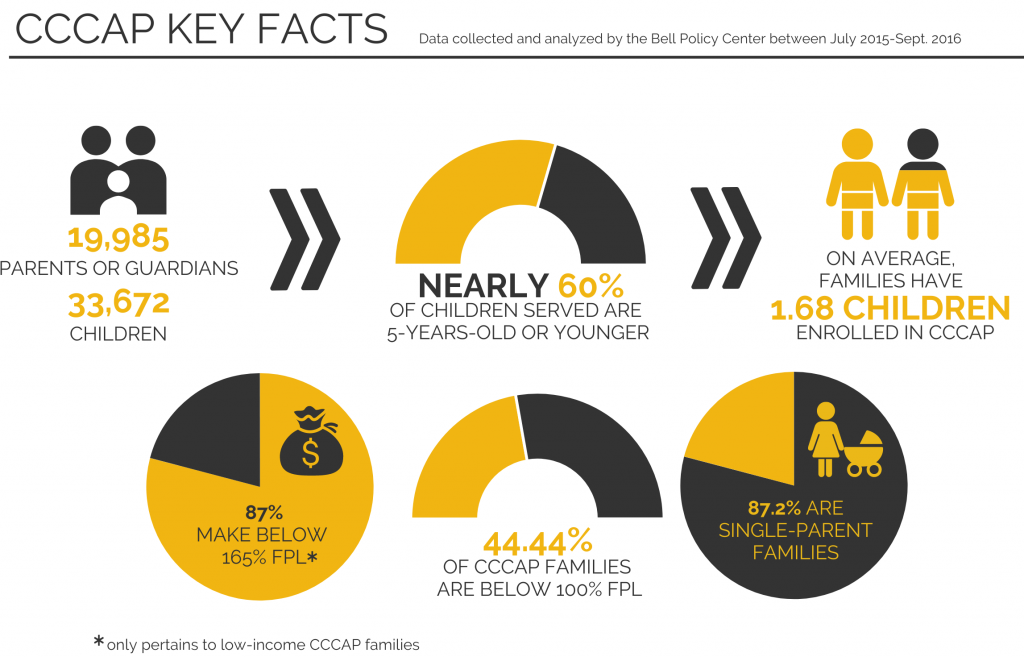A Look Past the Cliff: Understanding Colorado’s Cliff Effect Pilot Program
To better understand how the Colorado Cliff Effect Pilot Program helps families achieve economic mobility, the Bell Policy Center conducted a study examining advantages and areas for improvement.
Effectively serving Colorado’s children during their earliest years not only yields future societal savings, but provides immediate support to working parents. Intentionally linking job training and workforce development with quality child care is an important two-generation strategy benefitting both adults and children. Yet, affordable child care is financially out of reach for many families, particularly those who are low income.
The Colorado Child Care Assistance Program (CCCAP) is an important public work support and economic development program that helps low-income families make ends meet, while providing a safe and stable environment for children. The program provides subsidies to families to help cover the cost of child care while parents work or participate in another eligible activity, such as attending school or looking for work. However, the sudden loss of child care benefits due to rising income — “the cliff effect” — can harm families both in the short and long term. Families may change child care providers, opting for a less expensive and potentially lower-quality option if they can no longer afford the care they previously received. This poses risks for children, who benefit from routine and stable environments.
However, the sudden loss of child care benefits due to rising income — “the cliff effect” — can harm families both in the short and long term. Families may change child care providers, opting for a less expensive and potentially lower-quality option if they can no longer afford the care they previously received. This poses risks for children, who benefit from routine and stable environments.
The Colorado Cliff Effect Pilot Program (CEPP) was authorized in 2012 and updated in 2014 and 2016 to remedy this problem and turn the “cliff” into more of a “slope.” The program, implemented in 15 counties across Colorado, helps families whose incomes have increased above the eligibility limit, sometimes by very small amounts, by slowly increasing their child care payments instead of abruptly stopping all subsidized payments at once.
The Bell Policy Center surveyed a sample of CEPP and CCCAP families with incomes close to, but not exceeding, the eligibility limit in their county. We also interviewed several parents and county administrators.
Most families and county administrators praised CEPP because it provides families extra breathing room when they become ineligible for CCCAP. However, families reported feeling constantly worried about losing their child care benefits due to slight changes in income. The law authorizing CEPP was designed to require parents to pay increased subsidies over a two-year period, regardless of whether their income continued to increase over that time. As a result, country differences in CEPP design found some parents face increased costs more quickly than others. Families still encounter a cliff while on CEPP, and this could contribute to decisions that inhibit them from earning more.
While some parents expressed appreciation for the Colorado Cliff Effect Pilot Program, others did not distinguish between it and CCCAP. Others didn’t know it existed, suggesting more outreach, communication, and education might ensure parents are aware of this support, particularly as they approach the eligibility limit. County differences in CEPP design find some parents face increased costs more quickly than others, which also impacts their ability to sustain economic stability.
Our interviews provide insight into the variation of how the Colorado Cliff Effect Pilot Program is implemented and offer suggestions for improvements. This information can help policymakers better understand the program and how well it serves Colorado families.
Support for this project has been provided in part by the Chambers Fund, a donor-advised fund of the Women’s Foundation of Colorado.
Colorado Cliff Effect Pilot Program Recommendations
1. Policymakers should continue to refine CEPP and seek strategies to ameliorate the cliff effect.
2. Survey and anecdotal evidence from families and county officials demonstrated CEPP enabled some to achieve greater economic mobility.
3. Information about CEPP should be shared earlier and made more publicly available.
4. CEPP should link copay increases with household income increases.
5. CEPP and CCCAP may benefit from other implementation consistencies, and from counties learning from one another.
6. Colorado must strengthen public investment to create child care affordability to curb the high cost for working families.

